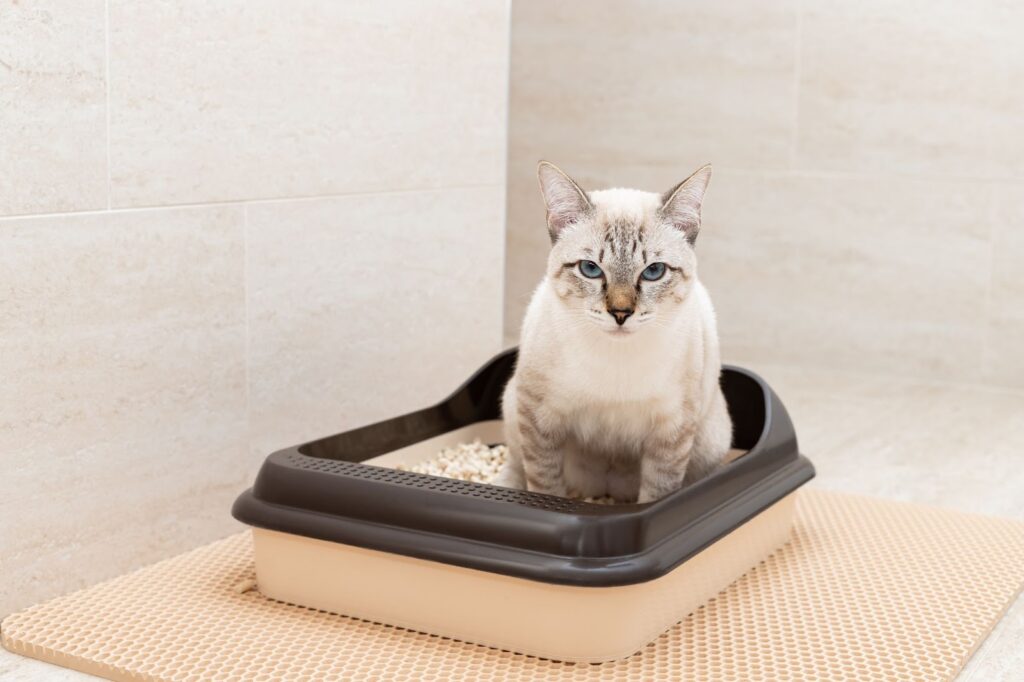Training Your Cat to Use a Litter Box

Keeping your home clean and odor-free can sometimes be a challenge. That’s where training your cat to use a litter box comes in. Whether you have a new kitten or an older cat who needs a refresher course, we’re here to help.
We’ll dive into understanding your cat’s behavior and preferences, choosing the right litter box and litter for your furry friend, as well as tips for solving common litter box problems.
The Importance of training your cat to use a litter box
Having a well-trained cat who knows the importance of using the litter box is essential for both their wellbeing and your sanity. Litter box etiquette goes beyond just cleanliness; it’s about ensuring that your feline friend feels comfortable, secure, and in control of their bathroom habits.
- Proper litter box etiquette helps maintain a hygienic environment for both you and your cat. By providing them with a designated spot to do their business, you can easily contain and manage any mess or odors. This not only keeps your home smelling fresh but also reduces the risk of bacterial contamination.
- Cats are naturally clean animals who value their privacy. A properly trained cat will appreciate having an appropriate place to relieve themselves without feeling anxious or stressed. It provides them with a sense of security and stability within their territory.
- Maintaining good litter box etiquette can help prevent behavioral issues in cats. When cats have consistent access to a clean litter box that meets their preferences, they are less likely to engage in inappropriate elimination behaviors such as urinating outside the box or on furniture.
Understanding Your Cat’s Behavior and Preferences
Cats are unique creatures with their own set of behaviors and preferences. By understanding your cat’s natural instincts, you can create a litter box environment that meets their needs.
Cats have an innate desire for privacy when using the litter box. They prefer a quiet and secluded area where they feel safe. Placing the litter box in a busy or noisy location can cause stress and deter them from using it.
Cats are known for their cleanliness. They have an instinctual need to bury their waste after eliminating. This is why choosing the right type of litter is crucial. Experiment with different textures and materials to find one that your cat finds comfortable to dig in.
Additionally, some cats may have specific preferences when it comes to litter depth. While most cats prefer a shallow layer of litter, others might enjoy a deeper pile for digging purposes.
Furthermore, observing your cat’s body language can give valuable insights into their behavior around the litter box. If your cat consistently avoids or shows signs of discomfort while using the current setup, it may be time to reassess and make necessary adjustments.
Choosing the Best Cat Litter Box
Cats have different preferences when it comes to their restroom habits, so it’s important to consider their needs.
Size:
Size matters when selecting a litter box. It should be large enough for your cat to comfortably move around in without feeling cramped.
Some cats prefer covered boxes for privacy, while others may feel more comfortable with an open design that allows them to survey their surroundings as they do their business.
Type:
There are various options available, such as clumping clay, silica gel crystals, recycled paper pellets, or natural alternatives like pine or wheat-based litter.
Consider your cat’s preferences and any sensitivities they may have before making a decision.
Keep hygiene in mind when choosing a litter box and litter material. Look for easy-to-clean options that can be quickly scooped or sifted through without creating too much mess or dust.
Also Read: Best 5 Cat Litter Box of 2024

Training Your Cat to Use the Litter Box
When it comes to litter box training for cats, patience and consistency are key. Cats are naturally clean animals, so teaching them proper litter box etiquette is usually a breeze. Here are some tips to help you successfully train your feline friend.
1- Choose a quiet and easily accessible location for the litter box.
Cats prefer privacy when doing their business, so placing the litter box in a low-traffic area of your home will ensure they feel comfortable using it.
2- Introduce your cat to the litter box gradually.
Start by placing them inside the box after meals or naps. This will help establish a routine and show them that this is where they should go when nature calls.
3- If accidents happen outside of the litter box
Never punish your cat. Instead, gently redirect them back to the appropriate spot and reward them with praise or treats when they use it correctly.
It’s also important to keep the litter box clean at all times. Scoop out waste daily and replace the entire contents once a week. Cats have sensitive noses and may avoid using an uncleaned or smelly litter box.
If you have multiple cats in your household, provide each one with their own separate litter boxes. Some cats prefer having their own space while others may be territorial about sharing.
Remember that every cat is unique and may require different approaches during training. Be patient with your furry friend as they adjust to using their new restroom facilities!
Tips for Maintaining a Clean and Odor-Free Litter Box
Keeping your cat’s litter box clean and odor-free is essential for both you and your feline friend. Here are some simple tips to help you maintain a clean and fresh-smelling litter box.
1- Regular Scooping:
One of the most important things you can do is to scoop the litter box daily. This helps remove any waste, keeping the area clean and preventing unpleasant odors from lingering.
2- Deep Cleaning:
It’s also crucial to deep clean the litter box on a regular basis. Empty out all of the old litter, scrub the box with mild soap or cat-friendly cleaner, rinse thoroughly, and add fresh litter.
3- Odor Control Products:
Consider using odor control products such as deodorizers or baking soda in your cat’s litter box. These can help neutralize odors between cleanings.
4- Proper Ventilation:
Ensure that your cat’s litter box is placed in a well-ventilated area. Good airflow can help dissipate odors more effectively.
5- Litter Choice:
Choosing the right type of litter can make a big difference in maintaining cleanliness and controlling odors. Experiment with different options like clumping clay, silica gel crystals, or natural plant-based litters to see which works best for you and your cat.
6- Covered vs Uncovered Cat Litter Box:
Some cats prefer uncovered boxes while others feel more secure in covered ones. Pay attention to your cat’s preferences as this could impact their willingness to use the litter box consistently.
Maintaining a clean and odor-free litter box is crucial not only for your comfort but also to encourage your cat to continue using it. Regular scooping, cleaning, and refreshing the litter will go a long way in keeping both you and your furry companion happy.
With a little effort and understanding from both sides, teaching your feline friend proper litter box etiquette is definitely achievable. Take the time to provide them with a comfortable space where they feel safe doing their business – it’ll make life easier for everyone involved!
Read: Should you use crystal litter for cats?
If you loved this article, you will also love reading our eBook Dubai Ruff Guide
For more furry destinations, the latest blogs, events, and providers you can stay updated by following us on Instagram and signing up for our newsletters.

